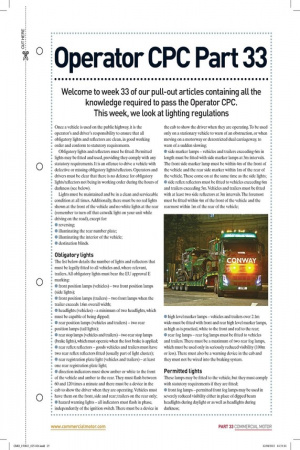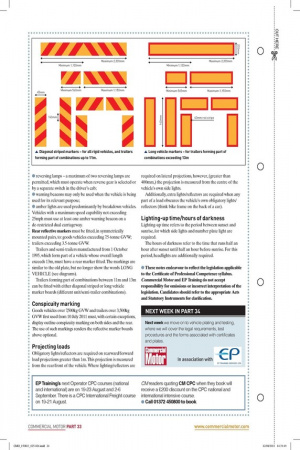Operator CPC Part 33 Welcome to week 33 of our
Page 22

Page 23

If you've noticed an error in this article please click here to report it so we can fix it.
pull-out articles containing all the knowledge required to pass the Operator CPC. This week, we look at lighting regulations
Once a vehicle is used on the public highway, it is the operator's and driver's responsibility to ensure that all obligatory lights and reflectors are clean, in good working order and conform to statutory requirements.
Obligatory lights and reflectors must be fitted. Permitted lights may be fitted and used, providing they comply with any statutory requirements. It is an offence to drive a vehicle with defective or missing obligatory lights/reflectors. Operators and drivers must be clear that there is no defence for obligatory lights/reflectors not being in working order during the hours of darkness (see below). Lights must be maintained and be in a clean and serviceable condition at all times. Additionally, there must be no red lights shown at the front of the vehicle and no white lights at the rear (remember to turn off that catwalk light on your unit while driving on the road), except for: • reversing; • illuminating the rear number plate; • illuminating the interior of the vehicle;
• destination blinds. Obligatory lights The list below details the number of lights and reflectors that must be legally fitted to all vehicles and, where relevant, trailers. All obligatory lights must bear the EU approval E marking: • front position lamps (vehicles) — two front position lamps (side lights); • front position lamps (trailers) — two front lamps when the trailer exceeds 1.6m overall width; • headlights (vehicles) — a minimum of two headlights, which must be capable of being dipped; • rear position lamps (vehicles and trailers) — two rear position lamps (tail lights); • rear stop lamps (vehicles and trailers) — two rear stop lamps (brake lights), which must operate when the foot brake is applied; • rear reflex reflectors — goods vehicles and trailers must have two rear reflex reflectors fitted (usually part of light cluster); • rear registration plate light (vehicles and trailers) — at least one rear registration plate light; • direction indicators must show amber or white to the front of the vehicle and amber to the rear. They must flash between 60 and 120 times a minute and there must be a device in the cab to show the driver when they are operating. Vehicles must have them on the front, side and rear; trailers on the rear only; • hazard warning lights — all indicators must flash in phase, independently of the ignition switch. There must be a device in the cab to show the driver when they are operating. To be used only on a stationary vehicle to warn of an obstruction, or when moving on a motorway or derestricted dual carriageway, to warn of a sudden slowing; • side marker lamps — vehicles and trailers exceeding 6m in length must be fitted with side marker lamps at 3m intervals. The front side marker lamp must be within 4m of the front of the vehicle and the rear side marker within lm of the rear of the vehicle. These come on at the same time as the side lights; • side reflex reflectors must be fitted to vehicles exceeding 6m and trailers exceeding 5m. Vehicles and trailers must be fitted with at least two side reflectors at 3m intervals. The foremost must be fitted within 4m of the front of the vehicle and the rearmost within lm of the rear of the vehicle; • high level marker lamps — vehicles and trailers over 2.1m wide must be fitted with front and rear high level marker lamps, as high as is practical, white to the front and red to the rear;
• rear fog lamps — rear fog lamps must be fitted to vehicles and trailers. There must be a maximum of two rear fog lamps, which must be used only in seriously reduced visibility (100m or less). There must also be a warning device in the cab and they must not be wired into the braking system. Permitted lights These lamps may be fitted to the vehicle, but they must comply with statutory requirements if they are fitted; • front fog lamps — permitted front fog lamps may be used in severely reduced visibility either in place of dipped beam headlights during daylight or as well as headlights during darkness; • reversing lamps a maximum of two reversing lamps are permitted, which must operate when reverse gear is selected or by a separate switch in the driver's cab; • warning beacons may only be used when the vehicle is being used for its relevant purpose;
• amber lights are used predominantly by breakdown vehicles. Vehicles with a maximum speed capability not exceeding 25mph must use at least one amber warning beacon on a de-restricted dual carriageway.
Rear reflective markers must be fitted, in symmetrically mounted pairs, to: goods vehicles exceeding 7.5-tonne GVVV; trailers exceeding 3.5-tonne GVVV.
Trailers and semi-trailers manufactured from 1 October 1995, which form part of a vehicle whose overall length exceeds 13m, must have a rear marker fitted. The markings are similar to the old plate, but no longer show the words LONG VEHICLE (see diagrams).
Trailers forming part of combinations between llm and 13m can be fitted with either diagonal striped or long vehicle marker boards (different unit/semi-trailer combinations). Conspicuity marking
Goods vehicles over 7,500kg GVVV and trailers over 3,500kg GVVV first used from 10 July 2011 must, with certain exceptions, display outline conspicuity marking on both sides and the rear. The use of such markings renders the reflective marker boards above optional. Projecting loads Obligatory lights/reflectors are required on rearward/forward load projections greater than lm. This projection is measured from the rear/front of the vehicle. Where lighting/reflectors are
required on lateral projections, however, (greater than 400mm,) the projection is measured from the centre of the vehicle's own side lights.
Additionally, extra lights/reflectors are required when any part of a load obscures the vehicle's own obligatory lights/ reflectors (think bike frame on the back of a car).
Lighting-up time/hours of darkness Lighting-up time refers to the period between sunset and sunrise, for which side lights and number plate light are required.
The hours of darkness refer to the time that runs half an hour after sunset until half an hour before sunrise. For this period, headlights are additionally required.
• These notes endeavour to reflect the legislation applicable to the Certificate of Professional Competence syllabus. Commercial Motor and EP Training do not accept responsibility for omissions or incorrect interpretation of the legislation. Candidates should refer to the appropriate Acts and Statutory Instruments for clarification.











































